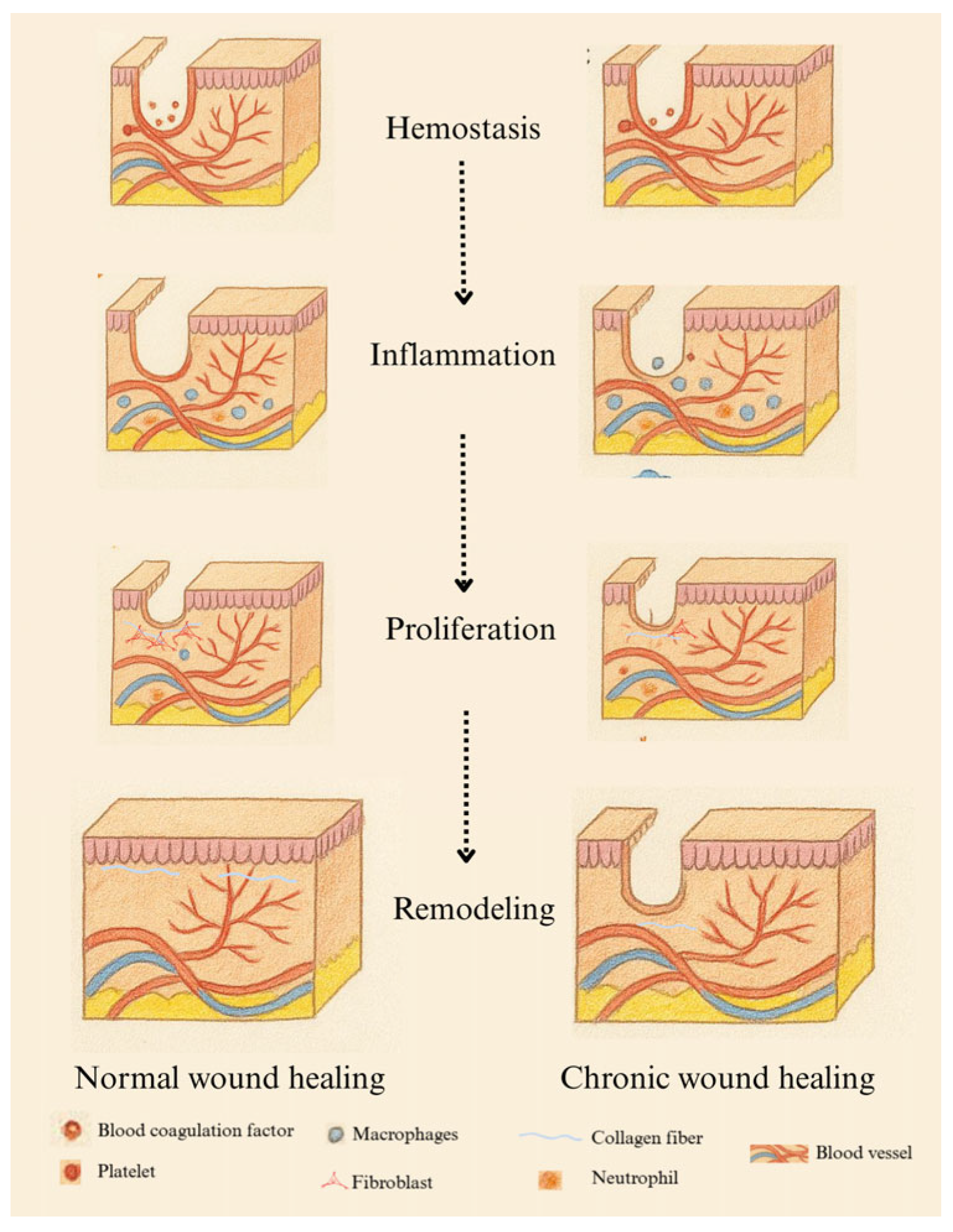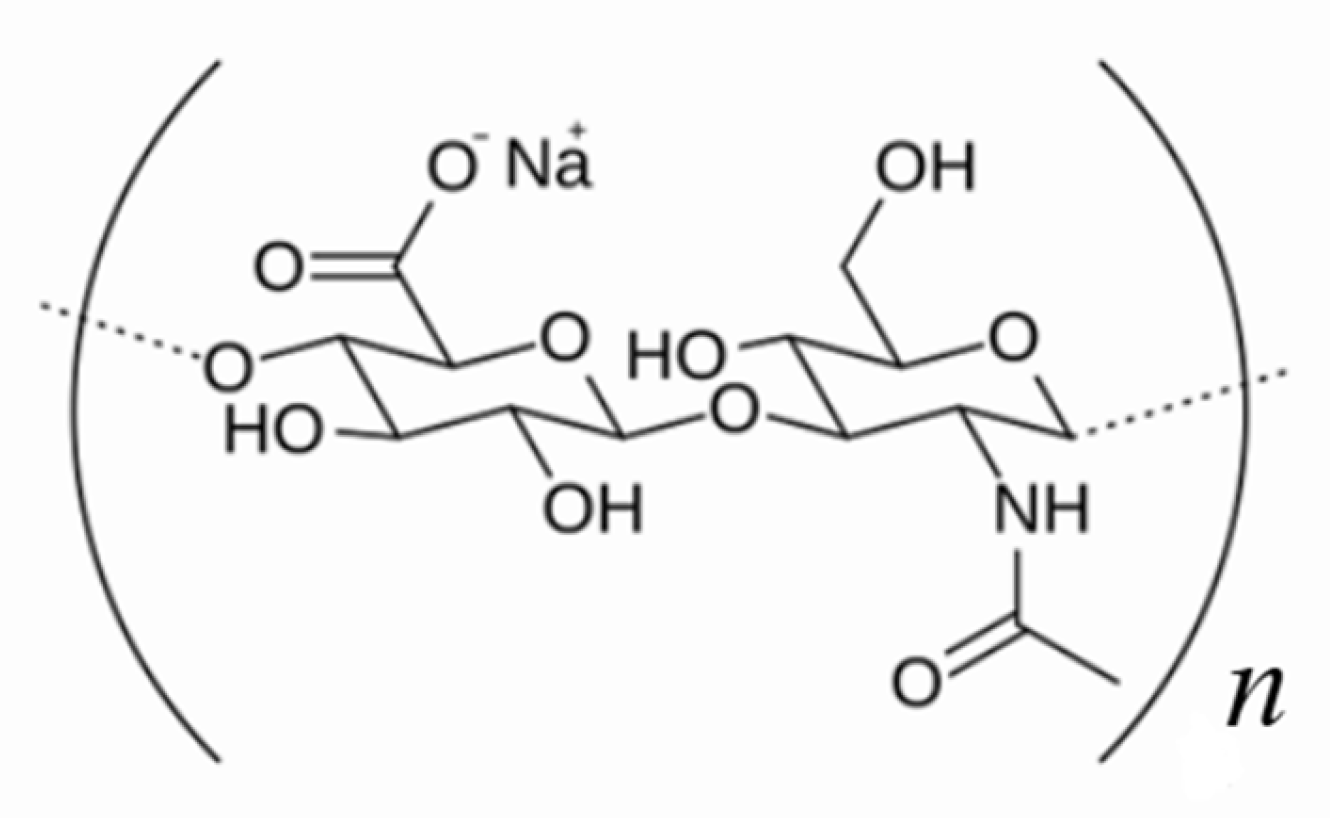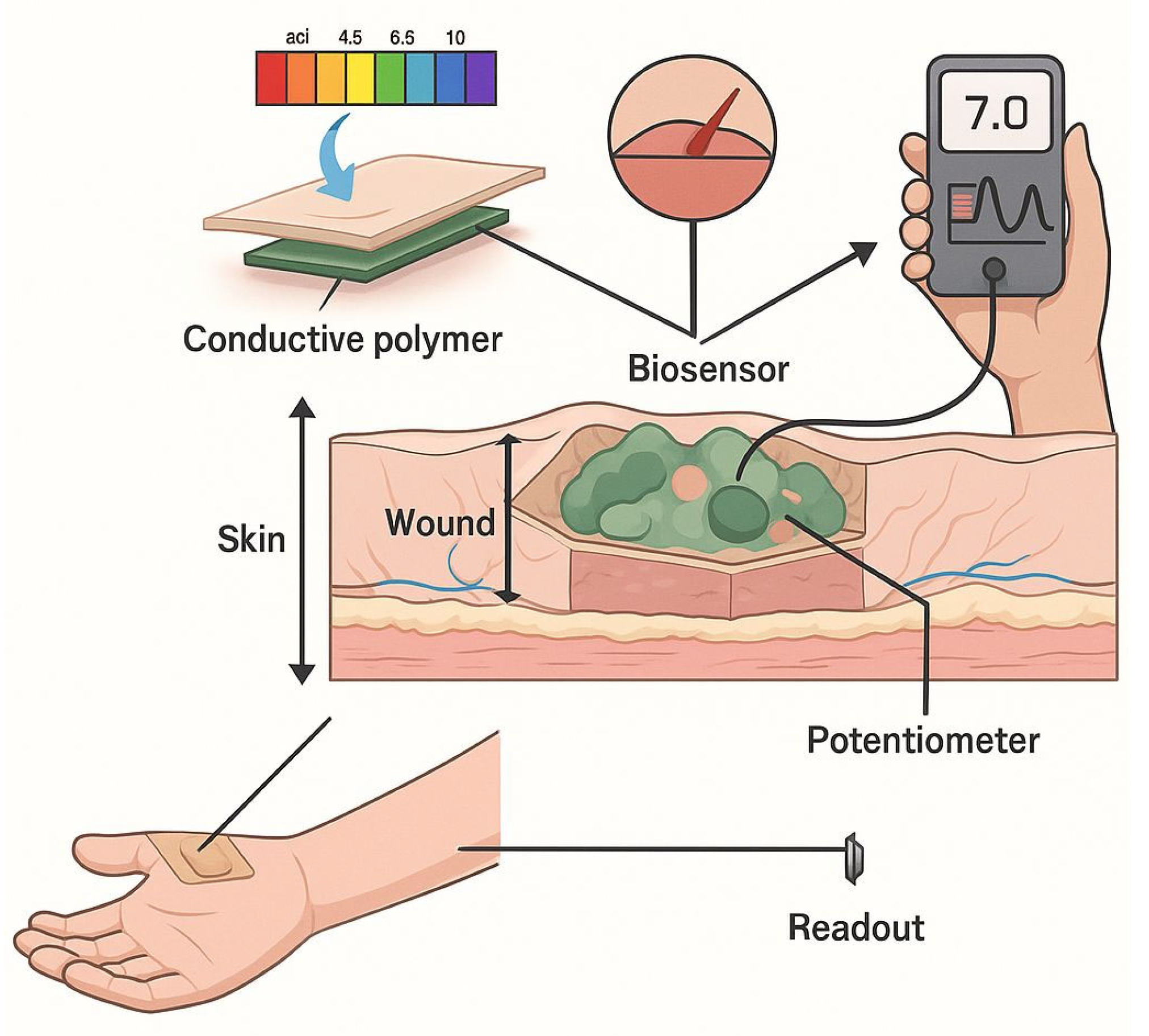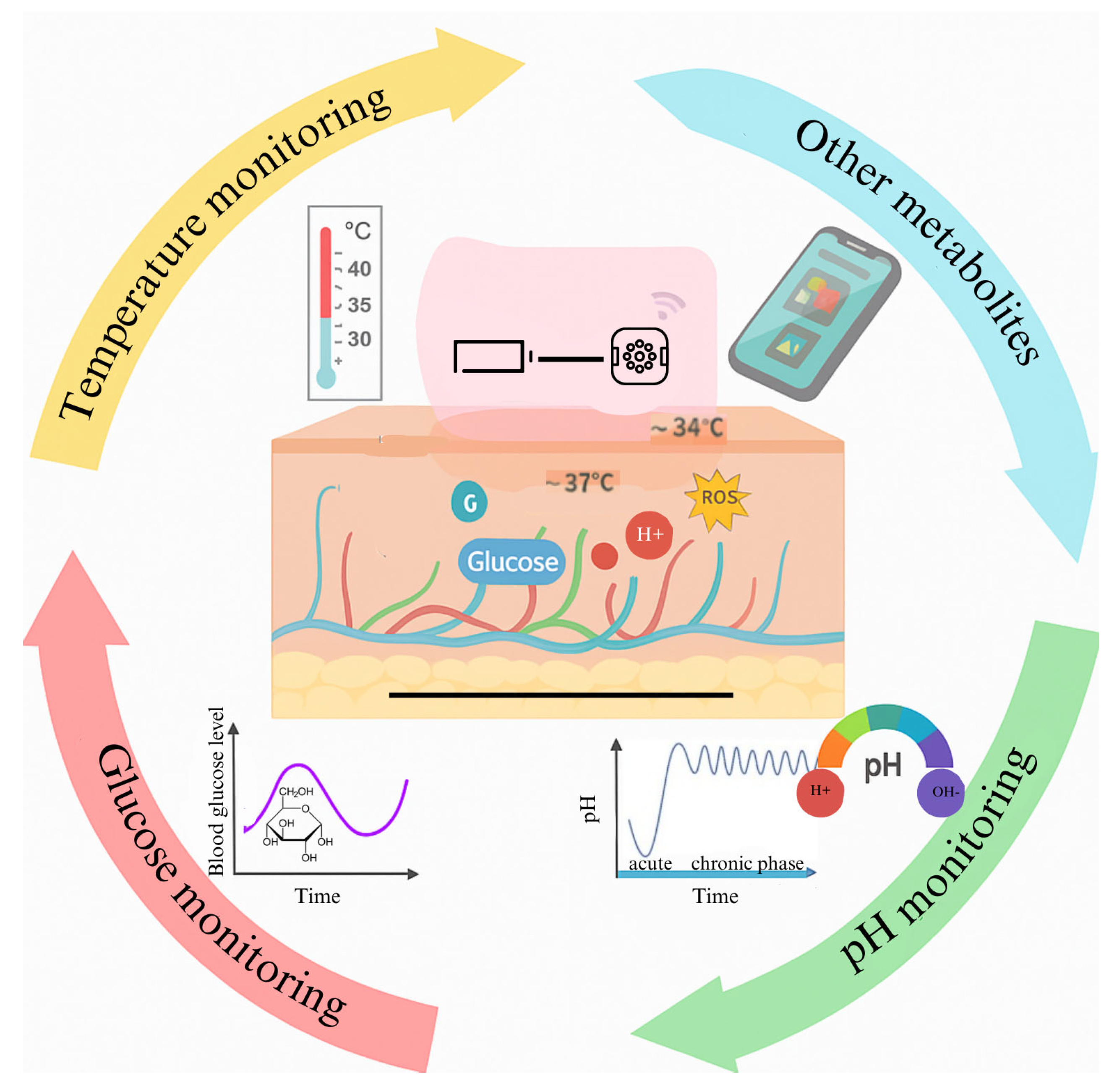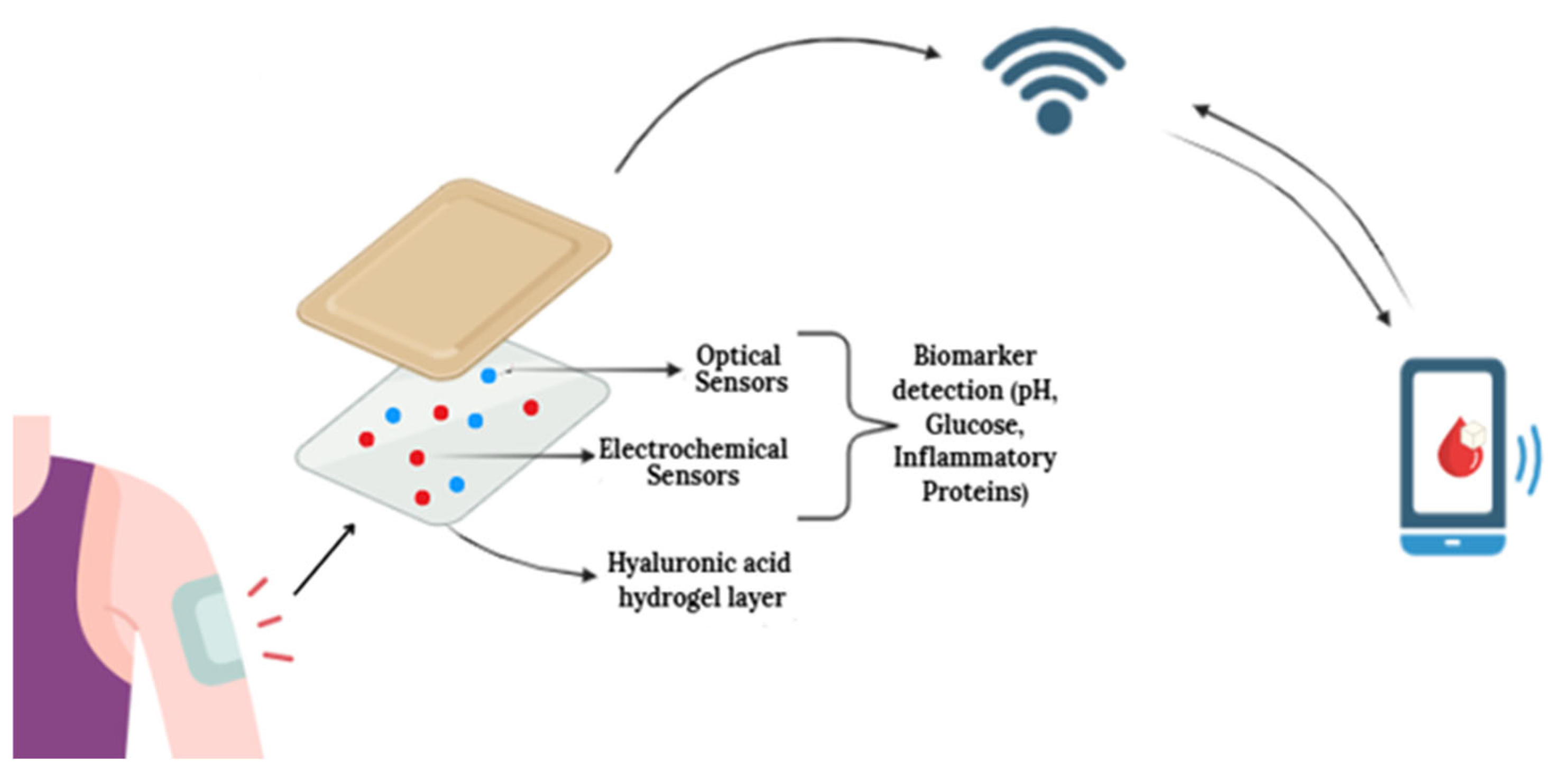1. Introduction
Chronic wounds, including diabetic foot ulcers, venous leg ulcers, and pressure ulcers, constitute a significant and growing global healthcare challenge, affecting over 13 million people worldwide and imposing considerable economic and social burdens [
1]. Predominantly affecting the elderly, chronic wounds are becoming increasingly widespread and harder to treat, often associated with substantial healthcare expenditures. Recent reports indicate that the five-year mortality rate for individuals with diabetes mellitus and foot ulcers is approximately 40% [
2]. These wounds fail to proceed through the normal stages of healing, hemostasis, inflammation, proliferation, and remodeling, resulting in prolonged patient suffering, increased risk of infection, and elevated morbidity and mortality [
2,
3]. Despite advances in wound care, effective management remains challenging due to the complexity of wound microenvironments, patient comorbidities, and, importantly, the lack of biosensor technologies capable of providing continuous, non-invasive, and reliable monitoring of key biochemical parameters directly at the wound site [
3].
Existing wound biosensors face significant limitations: many rely on rigid or semi-rigid substrates that reduce patient comfort and disrupt intimate contact with the wound bed; they often suffer from biofouling and signal instability in the moist, enzyme-rich environment; most detect only limited subset of biomarkers, offering an incomplete picture of wound status; and few can deliver real-time, continuous data without disturbing the tissue [
4].
Hydrogels based on natural polymers, particularly hyaluronic acid (HA), have emerged as promising materials for wound dressings due to their excellent biocompatibility, hydrophilicity, and ability to mimic the native extracellular matrix (ECM) [
3]. Hyaluronic acid plays a crucial biological role in tissue hydration, cell migration, and the modulation of inflammation, can encapsulate sensing elements, protect them from degradation, and allow selective diffusion of analytes such as pH, glucose, and inflammatory mediators, making it an ideal component in biosensors designed to monitor wound biomarkers such as pH, glucose, and inflammatory mediators [
3]. Incorporating HA hydrogels into sensor platforms facilitates the continuous and non-invasive assessment of wound status while maintaining a bioactive environment conducive to healing.
Recent developments have focused on integrating intelligent sensing capabilities with HA-based hydrogels to create multifunctional wound dressings capable of real-time biomarker detection and therapeutic intervention [
4]. These biosensors often combine optical and electrochemical detection methods, enabling precise quantification of critical analytes at physiologically relevant concentrations [
5]. However, persistent challenges include achieving long-term stability in the dynamic wound microenvironment, enabling simultaneous detection of multiple biomarkers, and maintaining optimal mechanical properties for patient comfort and sensor durability.
Artificial intelligence (AI) has recently been introduced as a powerful tool to enhance data analysis from these biosensors, offering advanced algorithms for pattern recognition, predictive modeling, and personalized wound management [
6]. Machine learning and deep learning techniques can interpret high-dimensional, time-series data generated by sensors to distinguish between normal and pathological healing trajectories, potentially enabling earlier clinical interventions [
6]. Nonetheless, the integration of AI in wound care also requires addressing challenges related to data standardization, quality assurance, patient privacy, and compliance with regulatory frameworks.
This review critically evaluates the current state of HA hydrogel-based biosensors for chronic wound monitoring, emphasizing how HA materials specifically address key gaps in existing biosensor technologies. It further explores AI’s role in improving biosensor data interpretation and discusses future directions for developing fully integrated, intelligent wound care systems. Our objective is to provide a comprehensive overview that supports the design of next-generation smart dressings capable of improving healing outcomes and patient quality of life. All articles included met the criteria: experimental or clinical application of HA-based hydrogel biosensors; monitoring at least one biomarker (pH, glucose, inflammatory proteins); direct integration of HA into the sensor matrix; and sufficiently detailed detection techniques for reproducibility [
3,
6].
2. Chronic Wound
Wound healing is a complex physiological process that occurs in four overlapping phases: hemostasis, inflammation, proliferation, and remodeling. The hemostatic phase begins immediately after injury, with vasoconstriction and blood clotting, which prevents blood loss and forms a provisional matrix for cell migration. The inflammatory phase lasts up to seven days, during which neutrophils and macrophages clear the wound and release growth factors. The proliferative phase follows, characterized by granulation tissue formation, new blood vessel growth, and epithelialization. The final remodeling phase can last up to two years, during which collagen is organized and strengthened [
7].
Chronic wounds fail to progress through normal healing stages, often getting stuck in the inflammatory phase (
Figure 1). They exhibit high levels of pro-inflammatory cytokines, proteases, and reactive oxygen species (ROS), along with persistent infections and dysfunctional stem cells. Excessive protease activity degrades the extracellular matrix (ECM), preventing transition to the proliferative phase. Additionally, oxidative stress increases ROS levels, which damage ECM proteins and worsen inflammation [
7,
8]. Research suggests that potent antioxidants can mitigate ROS levels and support the healing process.
Another major issue in chronic wounds is the presence of senescent cells, which have impaired proliferative and secretory functions, making them unresponsive to normal healing signals. Fibroblasts, keratinocytes, endothelial cells, and macrophages in chronic wounds often exhibit senescence, contributing to delayed healing. This dysfunction is linked to oxidative stress and metabolic abnormalities, particularly in diabetic patients [
8,
9].
Mesenchymal stem cells (MSCs) play an essential role in wound healing, but in patients with chronic wounds or diabetes, these cells are often deficient or defective (
Figure 2). Direct delivery of functional donor-derived MSCs may help restore healing capacity [
10].
In
Figure 2, the progressive stages of diabetic foot ulcer development are illustrated, starting from stage 0 (no open lesions or healed lesions) to stage 5 (complete gangrene of the foot). Stage 1 represents a superficial ulcer, not penetrating into deeper tissue layers; stage 2 shows a deep ulcer extending to the tendon, bone, or joint; stage 3 depicts deep ulcers with infected tissues, also referred to as osteitis; stage 4 indicates partial gangrene of the foot; and stage 5 corresponds to gangrene affecting the entire foot.
Proper management of chronic wounds requires addressing underlying systemic issues such as infection or vascular disease. Effective treatment begins with a thorough patient and wound assessment, followed by targeted interventions to remove contributing factors. Wound bed preparation is essential to creating an optimal healing environment. Accurate diagnosis is fundamental for determining the wound’s etiology, whether it be diabetic foot ulcers (DFUs), venous leg ulcers (VLUs), pressure ulcers (PUs), post-surgical wounds, or atypical wounds like pyoderma gangrenosum. Clinicians must also rule out malignancy, particularly in cases of squamous cell carcinoma [
11,
12].
4. Principles of Hyaluronic Acid-Based Biosensors
The versatility of HA allows for functionalization with conductive nanomaterials such as graphene and gold nanoparticles, as well as bioactive molecules, enhancing its applicability in biosensors. Through chemical modifications such as cross-linking or conjugation with functional groups, HA hydrogels can be tailored to achieve selective analyte detection and improved mechanical stability [
3,
24]. These modifications also enhance sensor performance for real-time monitoring: the hydrated, porous HA network facilitates rapid diffusion of biomarkers to the sensing elements, improving sensitivity, while its viscoelasticity and semi-permeable structure provide mechanical and chemical stability, ensuring consistent signal acquisition even in dynamic or enzyme-rich wound environments. Functionalization with conductive elements enhances HA’s electrical properties, allowing it to be used in electrochemical biosensors for precise biomarker detection. Additionally, HA-based nanocomposites improve sensor sensitivity and durability, ensuring long-term functionality in chronic wound monitoring by meeting key needs such as: continuous, real-time data acquisition without disturbing the wound bed, reliable multi-biomarker detection in moist, enzyme-rich environments, high biocompatibility to avoid irritation or rejection, and long-term sensor stability to reduce dressing changes [
5].
Hyaluronic acid-based biosensors integrate biocompatible hydrogel matrices with advanced sensing mechanisms to enable real-time monitoring of chronic wound healing. The intrinsic hydration and semi-permeable network of HA allow efficient interaction with wound exudates and rapid biomarker transport, which enhances the responsiveness of embedded sensors. At the same time, the mechanical resilience of HA maintains structural integrity during prolonged monitoring, contributing to sensor stability. These platforms address the actual clinical requirements of chronic wound monitoring, specifically, early infection detection, accurate tracking of healing phases, differentiation between transient and pathological inflammatory responses, and seamless integration with predictive analytics tools, thus supporting timely and personalized treatment decisions. These biosensors detect critical biomarkers such as pH, glucose, inflammatory proteins, and temperature variations, offering valuable insights into wound healing. The core principle of their operation is the ability of hyaluronic acid (HA) to form a hydrated, semi-permeable matrix that interacts with wound exudates, allowing for efficient diffusion of target molecules to embedded sensing elements [
6]. Additionally, based on the information gathered from these sensors, the release of HA can be triggered, further enhancing the wound healing environment by providing necessary moisture and promoting tissue repair.
The biosensors embedded within HA hydrogels typically operate through optical or electrochemical detection methods. Optical sensors rely on fluorescence, colorimetric changes, or luminescence in response to variations in biomarker concentrations. These biosensors provide a non-invasive and real-time assessment of the wound environment, allowing for visual tracking of healing progress. The fluorescence-based sensors, for example, exhibit intensity changes in response to pH fluctuations, indicating potential infection or tissue regeneration status [
25]. Electrochemical sensors detect biomolecular interactions within the hydrogel matrix by measuring electrical properties such as impedance, current, or potential differences. The changes in these parameters reflect variations in biomarker levels, enabling precise and quantitative wound assessment. Such sensors can be miniaturized and embedded within flexible hydrogel structures for enhanced biocompatibility and real-time monitoring [
25]. The combination of HA’s conductivity, porosity, and mechanical stability with these sensing methods is what allows accurate, continuous monitoring without sensor degradation or signal loss.
The integration of an AI-based chip into a hyaluronic acid (HA) hydrogel wound dressing can be achieved through flexible, biocompatible electronic designs. These may include stretchable circuit patterns printed on elastomeric substrates or “island–bridge” microchip layouts embedded within the hydrogel layer. The sensor components are positioned at the hydrogel–wound interface to collect data, while the AI-enabled chip, either embedded or connected wirelessly, processes the information in real time, enabling predictive analytics and personalized feedback for wound management [
26,
27].
We summarized the main experimental findings reported in the literature regarding hyaluronic acid-based hydrogel biosensors used for chronic wound monitoring. Key features include sensor design, biomarker detection capabilities, functional performance, and artificial intelligence (AI) integration.
4.1. Optical Biosensors
Healthy skin exhibits a slightly acidic pH between 4 and 6, which inhibits bacterial colonization. Upon injury, the pH rises towards neutrality (around 7.4), creating a conducive environment for bacterial proliferation [
2]. Chronic wounds typically exhibit a more alkaline pH range of 7 to 9, correlating with an increased risk of infection and impaired healing. Hyaluronic acid (HA)-based hydrogels functionalised with pH-sensitive dyes such as phenol red or hydroxyl-substituted azobenzene provide a biocompatible and highly swollen matrix capable of real-time pH monitoring [
5]. These optical sensors detect pH changes across a physiologically relevant range (5–10) through visible colorimetric shifts, enabling non-invasive wound status visualization (
Figure 5). Their swelling ratio can reach up to 400%, enhancing dye retention and sensor stability during prolonged wound application. The response time is rapid, typically under 2 min, making them suitable for continuous wound monitoring [
2]. One disadvantage of using optical biosensors based on hyaluronic acid is their limited stability under varying environmental conditions, which can affect sensor performance and accuracy over time.
4.2. Electrochemical Biosensors
Complementing optical methods, electrochemical pH sensors integrated into HA hydrogels utilize conductive polymers such as polyaniline (PANI), achieving Nernstian sensitivity (~59 mV/pH) across pH 4–9. These sensors, fabricated via screen-printing techniques with carbon and Ag/AgCl electrodes, offer high reproducibility and mechanical flexibility, making them suitable for wearable wound dressings (
Figure 6). Response times are generally under 30 s, enabling precise, real-time pH tracking critical for early infection detection and personalized treatment adjustment [
2,
5].
Wearable electrochemical pH sensors offer a more precise method for monitoring wound pH by measuring electrical potential and current. Early glass-electrode-based sensors measured electrical potential, while inorganic electrochemical sensors were later developed using materials like metals (Pd, Bi, Sb), metal oxides (TiO
2, ZnO), and others (Si
3N
4, InAs). For wound monitoring, flexible pH-sensitive polymers, including conductive (polyaniline—PANI), semiconducting (polythiophenes), and insulating (parylene) materials, were also created [
5].
Although hyaluronic acid (HA) provides advantages such as biocompatibility and resistance to biofouling in electrochemical biosensors, it also presents drawbacks like low electrical conductivity and possible instability under specific conditions. Additional limitations include the requirement for specialized stabilization methods to prevent aggregation, a potentially narrow strain-sensing range, and difficulties in scaling up production.
6. Integration with AI and Wireless Monitoring
In the context of wound healing, AI plays a pivotal role in improving the reliability and accuracy of (bio)sensor data by handling signal noise and optimizing detection thresholds. Integrating artificial intelligence (AI) with HA-based hydrogel biosensors transforms raw sensor data into actionable clinical insights, revolutionizing wound care management [
40]. This integration begins with continuous data acquisition, where biosensors embedded within the hydrogel matrix collect real-time information on key biomarkers such as pH, glucose, and inflammatory proteins from the wound microenvironment. The raw data undergoes preprocessing, consisting of filtering, smoothing, and normalization, to remove noise and artifacts, ensuring high data quality for reliable downstream analysis [
40,
41].
AI enhances sensor performance by directly improving signal interpretation and reliability. The effectiveness of AI and sensor integration is enhanced by the combination of advanced algorithms that compensate for sensor drift, enzymatic degradation, or environmental interference, effectively stabilizing long-term readings. Machine learning models can detect subtle biomarker changes that may be missed by standard thresholding, thereby increasing sensor sensitivity and enabling earlier detection of infection or delayed healing. Furthermore, AI can integrate multi-channel signals from functionalized HA hydrogels—such as pH-sensitive dyes, glucose oxidase reactions, or antibody-functionalised nanoparticles—optimizing signal extraction and reducing false positives caused by tissue movement or fluid variability [
42,
43,
44].
By analyzing patient-specific trends, AI can provide tailored recommendations. For example, adaptive thresholding adjusts biomarker alert levels according to individual healing patterns, distinguishing normal inflammation from pathological changes. Spatial analyses with CNNs detect localized infections or necrotic tissue zones, while LSTM models track temporal biomarker fluctuations to differentiate transient inflammatory spikes from sustained infection or stalled healing. This ensures that clinicians receive actionable insights that directly inform dressing changes, therapeutic interventions, or antibiotic administration, rather than relying solely on raw sensor data.
Moreover, HA hydrogel properties enhance AI effectiveness: the hydrated, semi-permeable, and mechanically stable matrix provides consistent biomarker diffusion and signal integrity, allowing AI models to generate accurate, reliable predictions over time. For enzymatic glucose sensors, AI maintains precise readings for long-term patient monitoring [
40,
41].
A dedicated software architecture is essential to ensure seamless integration of AI with HA-based hydrogel biosensors in clinical or home environments. The software pipeline encompasses the full journey from data acquisition to clinical decision support. The system begins by interfacing with hydrogel sensors via Bluetooth Low Energy (BLE) or ZigBee, periodically sampling biomarker data and applying real-time filtering with timestamping and metadata tagging [
45,
46]. On-device firmware can perform preliminary signal conditioning and event detection, such as sudden pH drops, and encrypt the data prior to transmission. Once transmitted to a mobile device or cloud server, AI models—such as SVMs, CNNs, or LSTMs—process the data to classify healing phases, identify complications, and forecast wound outcomes. AI continuously evaluates sensor performance, dynamically calibrates thresholds, and enhances real-time detection accuracy, ensuring that even minor deviations in biomarker levels are detected reliably. Adaptive calibration modules within this platform learn patient-specific trends, improving precision over time. A user-friendly dashboard visualizes the analyzed information, offering graphs, tissue maps, and alert notifications. These outputs can be synchronized with electronic medical records (EMRs) via HL7 or FHIR protocols, ensuring clinicians have real-time access to patient data and can intervene promptly when necessary [
45,
46].
Real-world and literature-supported examples underscore the feasibility of AI integration in wound monitoring. For instance, Kim et al. (2022) demonstrated an AI-driven optical sensor patch capable of detecting pH and temperature changes in chronic wounds, with wireless data transmission to clinicians, significantly reducing infection-related hospitalisations [
42,
47]. Similarly, Li et al. (2023) integrated an electrochemical glucose sensor into a hydrogel wound dressing, coupled with a cloud-based AI system that predicted delayed healing with over 90% accuracy [
42,
48]. Commercial tools also exist: the Wound Viewer is an AI-powered medical device capable of 3D wound measurement and automated analysis uploaded directly into the EMR, while the ImitoWound app enables patients to photograph wounds using mobile devices, compute size, and track healing over time, validated through high intraclass correlation coefficients [
33,
40,
49]. These cases demonstrate both the technical feasibility and clinical impact of AI-assisted HA hydrogel sensor platforms. (
Figure 9).
7. Discussion
The reviewed results highlight the growing potential of hyaluronic acid (HA)-based hydrogel biosensors in the monitoring of chronic wounds. These smart platforms enable real-time, non-invasive detection of key biomarkers, such as pH, glucose, and inflammatory proteins. Their integration with optical and electrochemical technologies allows accurate wound assessment and early identification of infection risks, representing a significant advancement over conventional, visual-only monitoring techniques [
2,
3].
HA-functionalized biosensors add diagnostic and therapeutic value compared to earlier hydrogel systems used solely for maintaining moisture. The inclusion of biosensing components and AI-driven analytics transforms passive dressings into intelligent therapeutic tools. For instance, pH-sensitive sensors provide dynamic feedback on the inflammatory status, while glucose-sensitive patches enable better glycemic control in diabetic wounds [
29].
A dual-responsive electrochemical biosensor was developed by integrating ultra-specific protein molecularly imprinted polymers (MIPs) and natural hyaluronic acid (HA) probes onto a flexible dual-channel screen-printed electrode (SPE) for the detection of the CD44 biomarker. MIPs were synthesized using alginate gel and CD44 as the template, while HA probes were immobilized on the second channel. The biosensor demonstrated high sensitivity and selectivity, with detection limits of 1.41 × 10
−5 ng/mL (MIPs) and 1.51 ×10
−5 ng/mL (HA), benefiting from the specificity, antifouling properties, and biocompatibility of both recognition elements, as well as the electrochemical stability of the SPE platform [
36]. Hyaluronic acid (HA) and poly(ethylene glycol) (PEG) were co-immobilized via a one-step biomimetic surface functionalization, enabling enhanced recognition of soluble CD44. The combined antifouling properties of HA and PEG synergistically improved sensing specificity [
45].
Considering the augmentation of effects of photobiomodulation for wound healing, an adhesive hyaluronic acid-based gelatin nanofibrous membrane integrated with multiple light-emitting diode (LED) arrays was developed as a skin-attachable patch [
23,
46].
From the perspective of previous studies, this convergence of biomaterials, biosensors, and AI reflects a broader trend in personalized medicine. Recent work by Fatima Mota et al. [
5] and Mei Qin et al. [
28] supports the notion that multifunctional biosensors embedded in flexible, biocompatible matrices can yield clinically actionable data without invasive procedures.
Future directions include developing fully self-powered biosensors, incorporating multi-biomarker detection in a single matrix, and integrating biosensor feedback with automated drug delivery systems. Cloud-based platforms using real-time sensor data and AI decision support may further enhance remote patient management and reduce healthcare burdens [
48].
However, translating these technologies into routine care remains challenging. This includes ensuring the long-term biocompatibility and stability of HA hydrogels in vivo [
18], addressing the power requirements for wearable sensors and wireless transmission, standardizing AI training datasets across diverse patient populations [
49,
50], and meeting regulatory criteria for data privacy and the ethical integration of AI in medical devices.
Conductive hydrogels (CHs) have become a key focus in developing smart wound dressings due to their unique properties that support both healing and monitoring. These materials support cell proliferation and migration by maintaining a stable structure and ensuring even current distribution across the wound [
50]. However, they still face challenges, such as balancing conductivity and biocompatibility, avoiding immune responses, and adapting to complex wound environments [
19].
Future research aims to improve CH design by making them more adaptive—able to dynamically respond to wound changes and optimize current conduction paths [
51]. Integrating AI could further enhance their potential by enabling automatic adjustments based on the wound-healing stage and providing personalized treatments [
52]. CHs combined with AI can provide precise sensing, monitoring, and data analysis, mimicking human senses like touch, smell, and vision.
Despite these advancements, several obstacles remain, including the collection of high-quality wound data, ensuring real-time monitoring, and maintaining stable skin contact without signal loss. Cloud-connected diagnostic platforms and multimodal sensing strategies could help manage the large, rapidly changing datasets generated by intelligent dressings. Developing flexible, low-power energy systems would also be essential to improve patient comfort and practicality [
51].
Incorporating artificial intelligence (AI) significantly enhances the diagnostic and predictive capabilities of HA-based biosensors. AI-driven algorithms analyze real-time sensor data, identifying patterns that indicate infection risks, delayed healing, or other complications. These algorithms utilize machine learning models trained on historical patient data, thereby enhancing the accuracy of wound assessment and facilitating early interventions [
51]. Berezo et al. developed a machine learning model capable of real-time prediction of the likelihood that chronic wounds will fail to heal by 4, 8, and 12 weeks after treatment initiation, based on assessments made at various time points [
53].
Wireless communication technologies further enhance the functionality of these biosensors by enabling remote monitoring (
Figure 10). This feature allows healthcare providers to continuously track patient progress and adjust treatment protocols accordingly [
25,
54].
Zheng et al. [
33] developed PETAL, a battery-free, paper-like AI-enabled sensor patch for real-time wound monitoring. It integrates five colorimetric sensors (pH, temperature, TMA, moisture, and uric acid) into a single paper patch, allowing rapid biomarker assessment within minutes. Using a deep learning algorithm and a smartphone, PETAL detects infection, inflammation, and wound conditions, classifies wound type and severity, and was validated both ex situ (with wound exudates) and in vivo (on rat models with chronic or burn wounds) [
54].
Privacy and data security concerns are also significant, especially as AI-powered systems require access to sensitive medical information. The absence of a unified regulatory framework complicates addressing issues related to data ownership and transmission. Ensuring data protection and transparency will be crucial for maintaining trust and achieving positive outcomes in AI-driven medical care [
6,
55].
By integrating AI with biosensor networks, personalized treatment strategies can be developed, optimizing patient outcomes and reducing the burden of chronic wound management on healthcare systems. Additionally, the AI algorithms can control the release of HA, ensuring that the wound environment receives continuous support for healing based on real-time sensor feedback.
8. Conclusions
Chronic wounds (CWs) remain a significant global health challenge, affecting millions of patients and often leading to severe complications and diminished quality of life. The development of innovative biosensors based on hyaluronic acid (HA) hydrogels represents a promising advancement in wound management, enabling real-time, non-invasive monitoring of key biomarkers such as pH, glucose, and inflammatory proteins. Optical and electrochemical sensor technologies have shown significant progress, particularly in detecting biomarkers like pH and temperature, with several commercialized devices—such as Biohealth, VeCare, and Smartheal—demonstrating their practical applicability [
6]. However, despite their clinical testing, these technologies are not yet widely implemented in routine practice due to production costs and scalability challenges.
Several factors must be addressed for these biosensing platforms to be successfully integrated into everyday medical practice. High sensitivity, biocompatibility, stability, and autonomous operation with wireless data transmission are important for widespread adoption. Moreover, considering that CWs are often fragile and require careful management, the materials used in these innovative dressings must be soft, non-aggressive, and comfortable for patients. Enhancing the mechanical and electrical conductivity of the sensors, as well as improving their durability and responsiveness, will be essential to their long-term success.
Integrating AI-driven data analysis with these biosensors further enhances their potential by enabling predictive analytics, early complication detection, and personalized treatment adjustments. These intelligent systems can optimize wound care strategies by continuously monitoring wound biomarkers in real time, allowing for timely interventions and improved healing outcomes [
53,
55].
In the future, the widespread adoption of HA-based hydrogel biosensors in wearable wound care devices has the potential to revolutionize personalized medicine. These advanced platforms will not only enhance wound healing and reduce complications but also provide clinicians and patients with precise, data-driven insights into wound management. As research continues to refine these technologies, their integration into routine healthcare settings will mark a transformative shift toward more efficient and effective chronic wound treatment.
9. Future Directions
Detection methods for chronic wound (CW) biomarkers face significant challenges due to the delayed diagnosis and difficulty in follow-up monitoring of wound healing. Traditional approaches rely on visual and physical examinations, patient medical history, and medication records. However, these methods are often subjective and require experienced professionals, making them ineffective for detecting underlying infected or dead tissues, which are critical for assessing wound healing. Conventional methods focus on identifying microorganisms at the wound site, as microbial presence is a key biomarker for CW diagnosis. Techniques like microbiological cultures are commonly used but have limitations, including the failure to identify non-culturable bacteria and the need for late-stage detection. Molecular assays, like rRNA-PCR and sequencing, provide more accurate results by detecting both cultivable and non-culturable bacteria, but they also face challenges like sample contamination and difficulty distinguishing active infections [
23].
Advanced methods like electrochemical bioimaging and microscopy are also used, but they require specialized equipment and often produce false-negative results due to irregular bacterial distribution. Despite these efforts, current techniques often focus only on bacterial pathogens and lack a comprehensive view of the wound microenvironment, which includes multiple biomarkers like immune response indicators, growth factors, and cytokines [
23].
Due to the high costs and inefficiency of current diagnostic approaches, there is an urgent need for innovative, accurate, and cost-effective detection methods. Recent research has explored sensor-based technologies for CW biomarker detection, providing real-time and reliable information on wound status. These sensors monitor changes in biomarker concentrations, such as enzyme levels and pH, which can indicate bacterial infection and delayed healing. Given the complexity and variability of the wound’s biological environment, developing sensors with high sensitivity, precision, and ease of use remains crucial for improving CW diagnosis and treatment outcomes [
5,
56].
Detection methods for chronic wound (CW) biomarkers face significant challenges due to the delayed diagnosis and difficulty in follow-up monitoring of wound healing. Traditional approaches rely on visual and physical examinations, patient medical history, and medication records. However, these methods are often subjective and require experienced professionals, making them ineffective for detecting underlying infected or dead tissues, which are critical for assessing wound healing [
2,
5].
While HA is relatively easy to functionalize, achieving consistent and reproducible results across large-scale production can be challenging. Surface and interfacial issues during manufacturing can also impact the (bio)sensor’s performance [
23]. HA, like other biomaterials, may require stabilization techniques (e.g., with nanoparticles or conductive polymers) to prevent aggregation or degradation [
51,
56].
Despite significant advances, integrating AI technologies into routine clinical practice remains a complex challenge. The structural properties of the hydrogel enable it to conform closely to tissue surfaces, minimizing mechanical mismatch and promoting seamless integration with the host. This close integration is essential for continuous monitoring applications, ensuring long-term sensor stability and reliable performance [
50,
57]. Key issues include ensuring HA hydrogels’ long-term biocompatibility and in vivo stability, managing power demands for wearable sensors and wireless communication, standardizing AI training datasets across diverse patient populations, and adhering to regulatory standards for data privacy and the ethical deployment of AI in medical devices.
Future developments of hydrogels aim to create fully self-powered biosensors, enable simultaneous detection of multiple biomarkers within a single platform, and link biosensor feedback to automated drug delivery systems [
58]. Additionally, cloud-based platforms that leverage real-time sensor data and AI-driven decision support could significantly improve remote patient monitoring and help alleviate pressures on healthcare systems.
